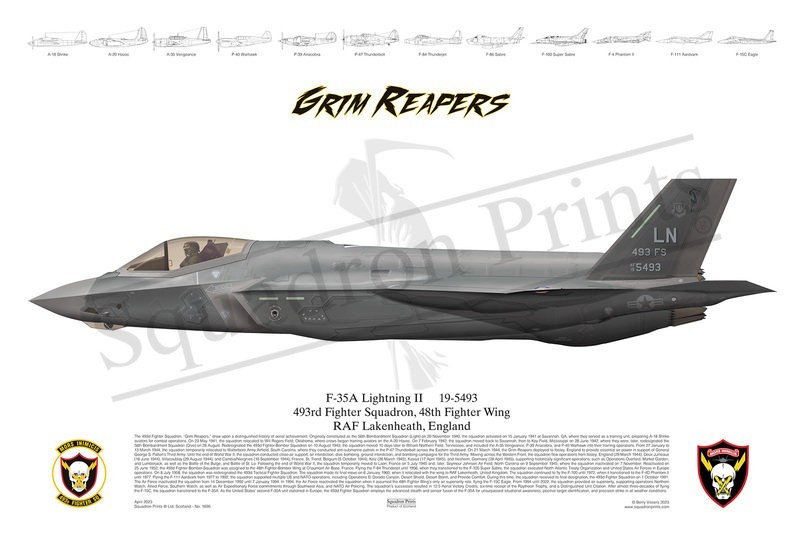#1695 493rd FS, F-35A Lightning II Squadron Print

Description
Squadron Prints Lithograph No. 1695 - 19-5493 '493 FS', F-35A Lightning II, 493rd Fighter Squadron, 48th Fighter Wing, RAF Lakenheath, England.
The 493d Fighter Squadron, “Grim Reapers,” draw upon a distinguished history of aerial achievement. Originally constituted as the 56th Bombardment Squadron (Light) on 20 November 1940, the squadron activated on 15 January 1941 at Savannah, GA, where they served as a training unit, preparing A-18 Shrike aviators for combat operations. On 23 May 1941, the squadron relocated to Will Rogers Field, Oklahoma, where crews began training aviators on the A-20 Havoc. On 7 February 1942, the squadron moved back to Savannah, then to Key Field, Mississippi on 28 June 1942, where they were, later, redesignated the 56th Bombardment Squadron (Dive) on 28 August. Redesignated the 493d Fighter-Bomber Squadron on 10 August 1943, the squadron moved 10 days later to William Northern Field, Tennessee, and included the A-35 Vengeance, P-39 Airacobra, and P-40 Warhawk into their training operations. From 27 January to 13 March 1944, the squadron temporarily relocated to Walterboro Army Airfield, South Carolina, where they conducted anti-submarine patrols in the P-47 Thunderbolt across the Eastern seaboard. On 21 March 1944, the Grim Reapers deployed to Ibsley, England to provide essential air power in support of General George S. Patton’s Third Army. Until the end of World War II, the squadron conducted close-air support, air interdiction, dive bombing, ground interdiction, and bombing campaigns for the Third Army. Moving across the Western Front, the squadron flew operations from Ibsley, England (29 March 1944), Deux Jumeaux (18 June 1944), Villacoublay (29 August 1944), and Cambia/Niergnies (16 September 1944), France, St. Trond, Belgium (5 October 1944), Kelz (26 March 1945), Kassal (17 April 1945), and Illesheim, Germany (28 April 1945), supporting historically significant operations, such as Operations Overlord, Market Garden, and Lumberjack, as well as the Battle of the Bulge, and Battle of St. Lo. Following the end of World War II, the squadron temporarily moved to Laon, France on 5 July 1945 and, later, Seymour Johnson Air Field, North Carolina on 9 September 1945, where the squadron inactivated on 7 November. Reactivated on 25 June 1952, the 493d Fighter Bomber-Squadron was assigned to the 48th Fighter-Bomber Wing at Chaumont Air Base, France. Flying the F-84 Thunderjet until 1956, when they transitioned to the F-100 Super Sabre, the squadron executed North Atlantic Treaty Organization and United States Air Forces in Europe operations. On 8 July 1958, the squadron was redesignated the 493d Tactical Fighter Squadron. The squadron made its final move on 6 January 1960, when it relocated with the wing to RAF Lakenheath, United Kingdom. The squadron continued to fly the F-100 until 1972, when it transitioned to the F-4D Phantom II until 1977. Flying the F-111 Aardvark from 1977 to 1992, the squadron supported multiple US and NATO operations, including Operations El Dorado Canyon, Desert Shield, Desert Storm, and Provide Comfort. During this time, the squadron received its final designation, the 493d Fighter Squadron on 1 October 1991. The Air Force inactivated the squadron from 14 December 1992 until 7 January 1994. In 1994, the Air Force reactivated the squadron when it assumed the 48th Fighter Wing’s only air superiority role, flying the F-15C Eagle. From 1994 until 2022, the squadron provided air superiority, supporting operations Northern Watch, Allied Force, Southern Watch, as well as Air Expeditionary Force commitments through Southwest Asia, and NATO Air Policing. The squadron’s successes resulted in 12.5 Aerial Victory Credits, six-time receipt of the Raytheon Trophy, and a Distinguished Unit Citation. After almost three-decades of flying the F-15C, the squadron transitioned to the F-35A. As the United States’ second F-35A unit stationed in Europe, the 493d Fighter Squadron employs the advanced stealth and sensor fusion of the F-35A for unsurpassed situational awareness, positive target identification, and precision strike in all weather conditions.
You may also like
-
SALE Ceramic mug RAF Coningsby UK flag
11 Sqn; 41 Sqn; 29 Sqn; 12 Sqn; BBMF; 3 SqnRAF Coningsby
